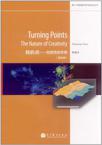转折点
2011-9
高等教育出版社
陈超美
268
无
创造性思维的背后有没有可以反复借鉴的思维方式?哪些是我们观察、思考、分析和决策中经常出现而又最容易被忽视的问题?如何才能系统性地提高我们自身的创造能力?本书《转折点——创造性的本质》(英文版)介绍了一系列具有代表性的观点、理论和实例以及在此基础上形成的一个知识发展的新理论,从理论和实践两个方面阐述了如何通过信息可视化、可视分析等方法直观地展现科学发展的宏观结构、趋势、变换及传播;此外还介绍了更为广泛的分析推理以及决策中常常遇到的几类问题和相关对策。
《转折点——创造性的本质》(英文版)由陈超美编著。
陈超美,美国德雷克赛尔大学信息科学与技术学院副教授,Information
Visualization期刊主编,大连理工大学长江学者讲座教授。主要研究领域包括信息可视化、科学前沿发展模式及科学发现理论、网络分析和信息计量学等。主要著作有lnformation
Visualization:Beyond the Horizon和Mapping Scientific Frontjers:The
Ouest for Knowledge Visualization,开发并推广了文献可视化分析软件CiteSpace。
Chapter 1 The Gathering Storm
1.1 The Gathering Storm
1.2 Into the Eye of the Storm
1.3 The Yuasa Phenomenon
1.4 Transformative Research and the Nature of Creativity
1.5 Science and Society
1.6 Summary
References
Chapter 2 Creative Thinking
2.1 Beyond Serendipity
2.2 The Study of Creative Work
2.3 Divergent Thinking
2.4 Blind Variation and Selective Retention
2.5 Binding Free-Floating Elements of Knowledge
2.6 Janusian Thinking
2.7 TRIZ
2.8 Summary
References
Chapter 3 Cognitive Biases and Pitfalls
3.1 Finding Needles in a Haystack
3.1.1 Compounds in Chemical Space
3.1.2 Change Blindness
3.1.3 Missing the Obvious
3.2 Mental Models and Biases
3.2.1 Connecting the Right Dots
3.2.2 Rejecting Nobel Prize Worthy Works
3.3 Challenges to be Creative
3.3.1 Reasoning by Analogy
3.3.2 Competing Hypotheses
3.4 Boundary Objects
3.5 Early Warning Signs
3.6 Summary
References
Chapter 4 Recognizing the Potential of Research
4.1 Hindsight
4.1.1 Hibernating Bears
4.1.2 Risks and Payoffs
4.1.3 Project Hindsight
4.1.4 TRACES
4.2 Foresight
4.2.1 Looking Ahead
4.2.2 Identifying Priorities
4.2.3 The Delphi Method
4.2.4 Hindsight on Foresight
4.3 Summary
References
Chapter 5 Foraging
5.1 An Information-Theoretic View of Visual Analytics
5.1.1 Information Foraging and Sensemaking
5.1.2 Evidence and Beliefs
5.1.3 Salience and Novelty
5.1.4 Structural Holes and Brokerage
5.1.5 Macroscopic Views of Information Contents
5.2 Turning Points
5.2.1 The Index of the Interesting
5.2.2 Proteus Phenomenon
5.2.3 The Concept of Scientific Change
5.2.4 Specialties and Scientific Change
5.2.5 Knowledge Diffusion
5.2.6 Predictors of Future Citations
5.3 Generic Mechanisms for Scientific Discovery
5.3.1 Scientific Discovery as Problem Solving
5.3.2 Literature-Based Discovery
5.3.3 Spanning Diverse Perspectives
5.3.4 Bridging Intellectual Structural Holes
5.4 An Explanatory and Computational Theory of Discovery
5.4.1 Basic Elements of the Theory
5.4.2 Structural and Temporal Properties
5.4.3 Integration
5.4.4 Case Studies
5.5 Summary
References
Chapter 6 Knowledge Domain Analysis
6.1 Progressive Knowledge Domain Visualization
6.1.1 Scientific Revolutions
6.1.2 Tasks
6.1.3 CiteSpace
6.2 A Multiple-Perspective Co-Citation Analysis
6.2.1 Extending the Traditional Procedure
6.2.2 Metrics
6.2.3 Clustering
6.2.4 Automatic Cluster Labeling
6.2.5 Visual Design
6.3 A Domain Analysis of Information Science
6.3.1 A Comparative ACA (2001-2005)
6.3.2 A Progressive ACA (1996-2008)
6.3.3 A Progressive DCA (1996-2008)
6.4 Summary
References
Chapter 7 Messages in Text
7.1 Differentiating Conflicting Opinions
7.1.1 The Da Vinci Code
7.1.2 Terminology Variation
7.1.3 Reviews of The Da Vinci Code
7.1.4 Major Themes
7.1.5 Predictive Text Analysis
7.2 Analyzing Unstructured Text
7.2.1 Text Analysis
7.2.2 Searching for Missing Links
7.2.3 Concept Trees and Predicate Trees
7.3 Detecting Abrupt Changes
7.3.1 A Burst of Citations
7.3.2 Survival Analysis of Bursts
7.3.3 Differentiating Awarded and Declined Proposals
7.4 Summary
References
Chapter 8 Transformative Potential
8.1 Transformative Research
8.2 Detecting the Transformative Potential
8.2.1 Connections between References and Citations
8.2.2 Measuring Novelty by Structural Variation
8.2.3 Statistical Validation
8.2.4 Case Study: Pulsars
8.3 Portfolio Evaluation
8.3.1 Identifying the Core Information of a Proposal
8.3.2 Information Extraction
8.3.3 Detecting Hot Topics
8.3.4 Identifying Potentially Transformative Proposals
8.4 Summary
References
Chapter 9 The Way Ahead
9.1 The Gathering Storm
9.2 Creative Thinking
9.3 Biases and Pitfalls
9.4 Foraging
9.5 Knowledge Domain Analysis
9.6 Text Analysis
9.7 Transformative Potential
9.8 Recommendations
Index
版权页:插图:The difference between Davis framework and Janusian thinking is subtle butsignificant. In Davis' framework, when we are facing two opposite and contra-dictory views, we are supposed to choose one of them. In contrast, Janusianthinking is not about choosing one of the existing views and discarding theother. Instead, we must come up with a new and creative perspective so thatit can accommodate and subsume all the contradictions. The contradictionsat one level are no longer seen as a problem at the new level of thinking.It is in this type of conceptual and cognitive transformation that discovererscreate a new theory that makes the co-existence of the antitheses meaningful.The ability to view things from multiple perspectives and reconcile con-tradictions is in the center of dialectical thinking. The origin of dialectics isa dialog between two or more people with different views but wish to seek aresolution. Socratics, Hegel, and Marx are the most influential figures in thedevelopment of dialectical thinking.According to Hegel, a dialectic process consists of three stages of thesis,antithesis, and synthesis. An antithesis contradicts and negates the thesis.The tension between the thesis and antithesis is resolved by synthesis. Eachstage of the dialectic thinking process makes implicit contradictions in thepreceding stage explicit. An important dialectical principle in Hegel's systemis the transition from quantity to quality. In the commonly used expression,"the last straw that broke the camel's back", the one additional straw is aquantitative change, where a breakdown camel is a qualitative change. Thenegation of the negation is another important principle for Hegel. To Hegel,human history is a dialectical process.Hegel was criticized by materialist or Maxist dialectics. In Karl Marx'sown words, his dialectic method is the direct opposite of Hegel's. To Marx,the material world determines the mind. Marxists see contradiction as thesource of development. In this view, class struggle is the contradiction thatplays the central role in social and political life. In Chapter 1 we introducedhow internalism and externalism differ in terms of their views of the natureof science and its role in the society. Dialectic thinking does seem to have aunique place in a diverse range of contexts.
《转折点:创造性的本质(英文版)》由新一代信息科学与技术丛书之一。

无
书是不错,但是当当网等我提交订单后才告知我缺货。有点可惜。